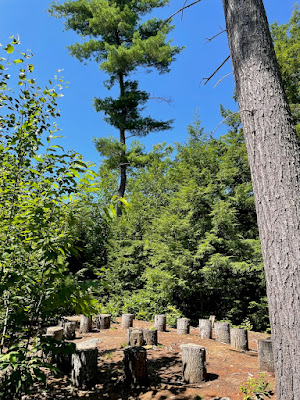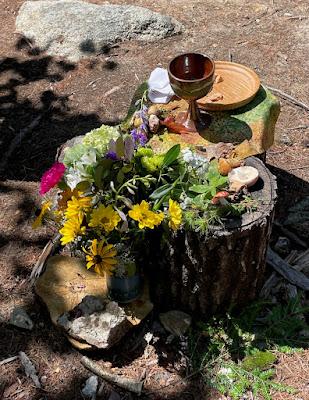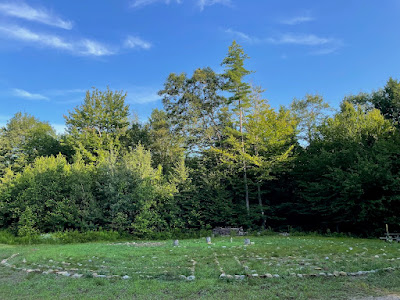The 106 acres are open at all times for visitors but a weekly service starts Sundays at 9:30, proceeding from a small parking clearing up to a place referred to as “the knoll,” a small clearing with an oval of tree stump stools around a cluster of three stumps, on which a ceramic chalice (decorated with a mountain pattern), a wooden plate and flowers from someone's garden await. (When it’s too cold or wet, the community meet in a barn.) As we began, the area of this altar shimmered in dappled light whenever a breeze tickled a small birch to one side. At either end of the oval, youngish white pines towered, surprisingly tall for a woods which, when Blackmer acquired it a decade and a half ago, had been messily logged of most larger trees.
The service is a traditional liturgy of Holy Communion but over the years it has congealed into a specific set of words and actions which cohere beautifully and beautifully with the woods. That this is a liturgy with a difference is clearest in the heart of the service, offertory and communion. Building in the experiences which had sustained forest conservationist Blackmer long before he was called to priesthood, the congregation disperses into the woods for 20 minutes after the lectionary readings and a brief homily. All are invited to bring back and share what they find. This is the offertory, and it came together like the most exquisite piece of flower arrangement, weaving together the life of the forest and each of the subjectivities gathered.
Each had been placed there with a few words, some connected to the readings. Besides flowers and leaves, ferns and firs, many of the offerings this time were mushrooms in various unusual colors and shapes, red and creamy and caramel and purple and tangerine orange, as well as ghostly white Indian pipes - how God loves diversity, one enthused! One woman had found a small maple leaf red anidst all the green, a reminder of the irresistible cycles of change. Another had been struck by nature's “groaning” mentioned in the reading from Romans (8:22), and realized that trees are groaning all the time, if you only listen. Another had gone out in search of scents, and found them in a tree bough. A man held up a single needle from one of the five-needle bushels of a white pine, reflecting that God was in all things: "Hello, Jesus!"
The liturgy of the Eucharist followed, on an altar now overflowing with the gifts of the woods and of reflection. But I’ve been writing as if the congregation comprised only the human beings gathered, even if we channeled the joy (and the groans) of nature. For Rev. Blackmer, every being in the woods is a full member of the congregation. The surrounds had been acknowledged in an opening prayer, accompanied by movements, inspired by “St. Patrick’s Breastplate”: Christ within me, Christ before me, Christ behind me, … The earth is Theotokos, the God bearer, and Christ’s sacrifice was for the whole world.
And so, when the words of consecration came – accompanied, I couldn’t help noticing, by the most sustained, if still gentle, shimmering rustle of leaves above – the bread, wine and water, “what earth has given and human hands have made,” were from all of us - and for all of us. After the breaking of the bread, the first piece was offered to the earth, placed among the gathered offerings on the makeshift altar. (Because there was such bounty, two pieces were left this time.) The next piece went to someone’s dog, standing in for the rest of living creation and clearly familiar with the proceeding! Unorthdox, to say the least, but I’d read about the offering to the earth, and this made sense as an extension of that, making it more than a metaphor.
After communion, the plate and cup having passed from hand to hand around the circle, Rev. Blackmer left the remaining bread on the plate on the stumps, and poured the remaining consecrated wine over the earth next to them. Rev. Blackmer was pleased when I told him, later, that this had shocked me - and then, seemed the most natural thing to do. He told me it was actually liturgically quite proper; leftover communion wine must either be consumed, or disposed of in a special sink, called a Piscina, which leads directly to the ground. But it was a jolt. If this isn't sacrilege, I immediately saw, what theological refusal of our earthbound existence as part of the community of life would make it seem so? Does not God love God's whole creation, and is not all of it redeemed by Christ's death and resurrection?
I wasn't expecting something so theologically challenging. I'd imagined something like a standard church service, just without the walls, the bread on the stump still on an altar elevated above the ground... but I also came because I sensed that reading about it wasn't enough to know its meaning. Witnessing and participating in these liturgical movements made me realize I'd still brought church walls with me, until I was shocked into understanding that I didn't need them, any more than it was a problem that ants and were plying their trade on the ground around the altar as we worshipped. "Sacred" means something like set apart, but why set one's religion apart from the created world of which we are a part? Maybe what's needed, if religion is not to distance us from the world and inure us to its groaning, is taking the walls down - even when in a church. Perhaps taking them down, setting the service apart from the world of merely human meaning and interaction, is what is demanded.
I hope I can find a way to return to the Church of the Woods. A less than perfect day might be perfect in other ways - the light and air and offerings all different yet from the same source - and a taste of the liturgical power in repetition. The best I could do was return for a quick visit before we left this morning. Our offerings, from and to the woods and the woods' God, were still there in the warm morning light, a vision of human life and striving as part of nature rather than built on its mindless destruction.
I also walked the Chartres labyrinth, which an ex-student (my connection to Church of the Woods) helped lay out some years ago.




